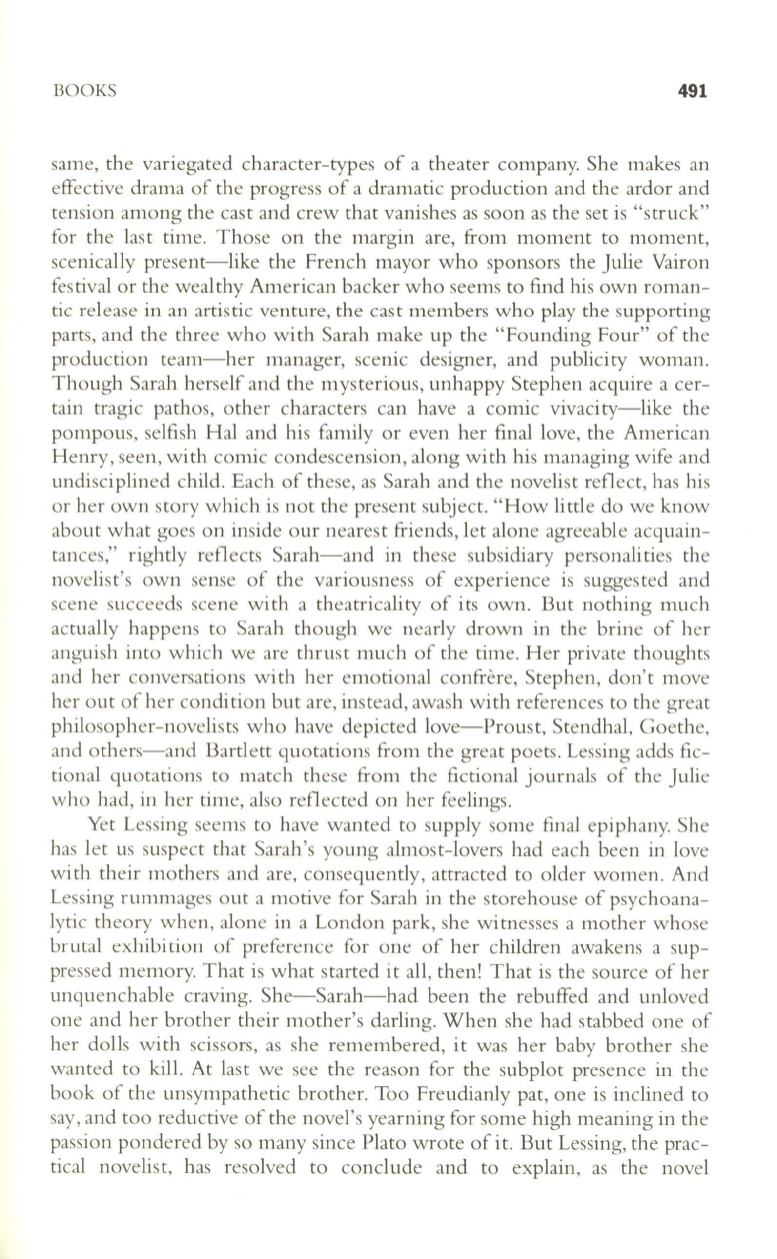
BOOKS
491
same, the variegated character-types of a theater company. She makes an
effective drama of the progress of a dramatic production and the ardor and
tension among the cast and crew that vanishes as soon as the set is "struck"
for the last time. Those on the margin are, from moment to moment,
scenically present-like the French mayor who sponsors the Julie Vairon
festival or the wealthy American backer who seems to find his own roman–
tic release in an artistic venture, the cast members who play the supporting
parts, and the three who with Sarah make up the "Founding Four" of the
production team-her manager, scenic designer, and publicity woman.
Though Sarah herself and the mysterious, unhappy Stephen acquire a cer–
tain tragic pathos, other characters can have a comic vivacity-like the
pompous, selfish Hal and his family or even her final love, the An'lerican
Henry, seen, with comic condescension, along with his managing wife and
undisciplined child. Each of these, as Sarah and the novelist reflect, has his
or her own story which is not the present subject. "How Ii ttle do we know
about what goes on inside our nearest friends, let alone agreeable acquain–
tances," rightly reflects Sarah-and in these subsidiary personalities the
novelist's own sense of the variousness of experience is suggested and
scene succeeds scene with a theatricality of its own. But nothing much
actually happens to Sarah though we nearly drown in the brine of her
anguish into which we are thrust much of the time. Her private thoughts
and her conversations with her emotional confrere, Stephen, don't move
her out of her condi tion but are, instead, awash with references to the great
philosopher-novelists who have depicted love-Proust, Stendhal, Goethe,
and others-and Bartlett quotations from the great poets. Lessing adds fic–
tional quotations to match these from the fictional journals of the Julie
who had, in her time, also reflected on her feelings.
Yet Lessing seems
to
have wanted to supply some final epiphany. She
has let us suspect that Sarah's young almost-lovers had each been in love
with their mothers and are, consequently, attracted to older women. And
Lessing rummages out a motive for Sarah in the storehouse of psychoana–
lytic theory when, alone in a London park, she witnesses a mother whose
brutal exhibi tion of preference for one of her children awakens a sup–
pressed memory. That is what started it all, then! That is the source of her
unquenchable craving. She-Sarah-had been the rebuffed and unloved
one and her brother their mother's darling. When she had stabbed one of
her dolls wi th scissors, as she remembered, it was her baby brother she
wanted to kill. At last we see the reason for the subplot presence in the
book of the unsympathetic brother. Too Freudianly pat, one is inclined to
say , and too reductive of the novel's yearning for some high meaning in the
passion pondered by so many since Plato wrote of it. But Lessing, the prac–
tical novelist, has resolved to conclude and to explain, as the novel


